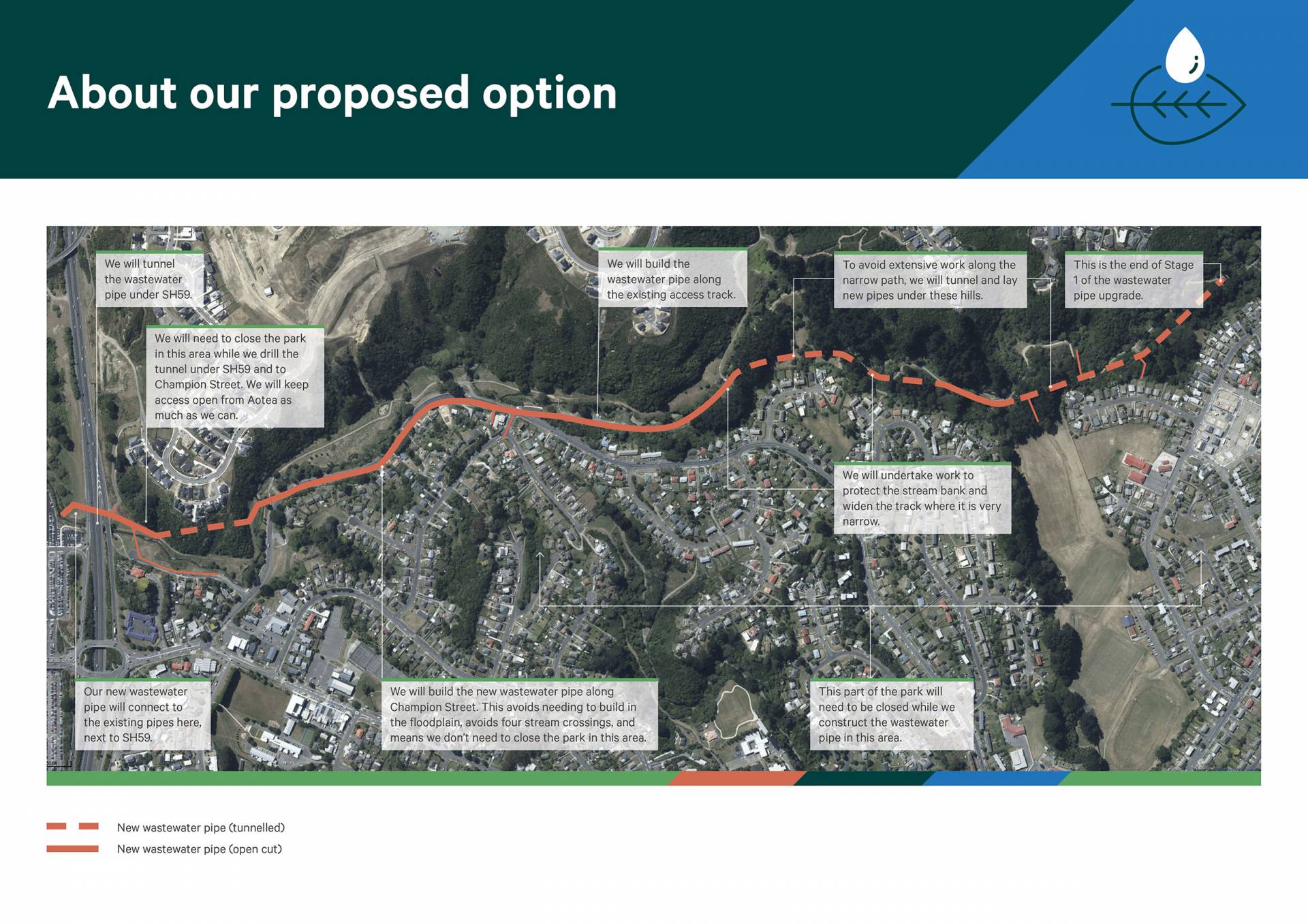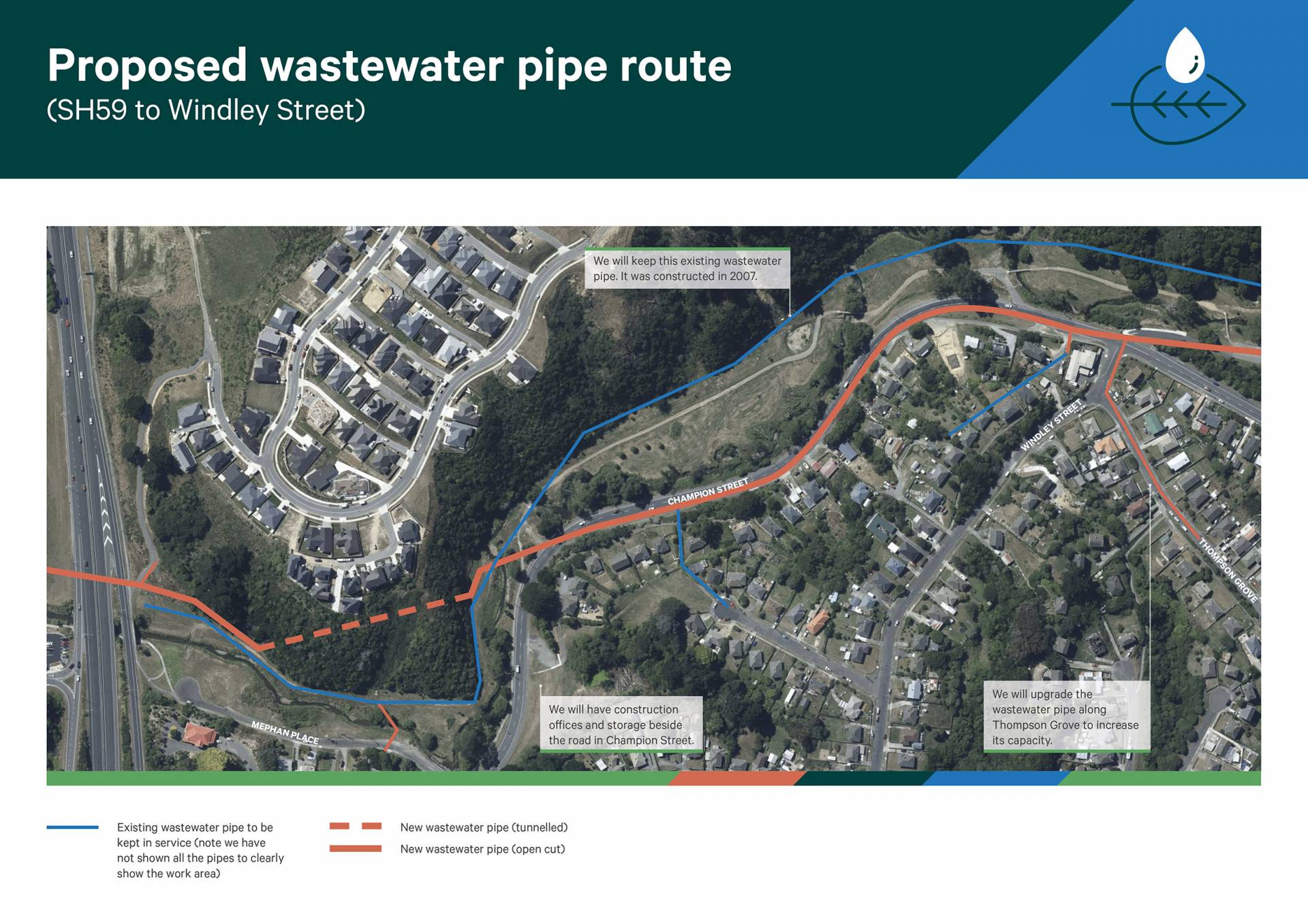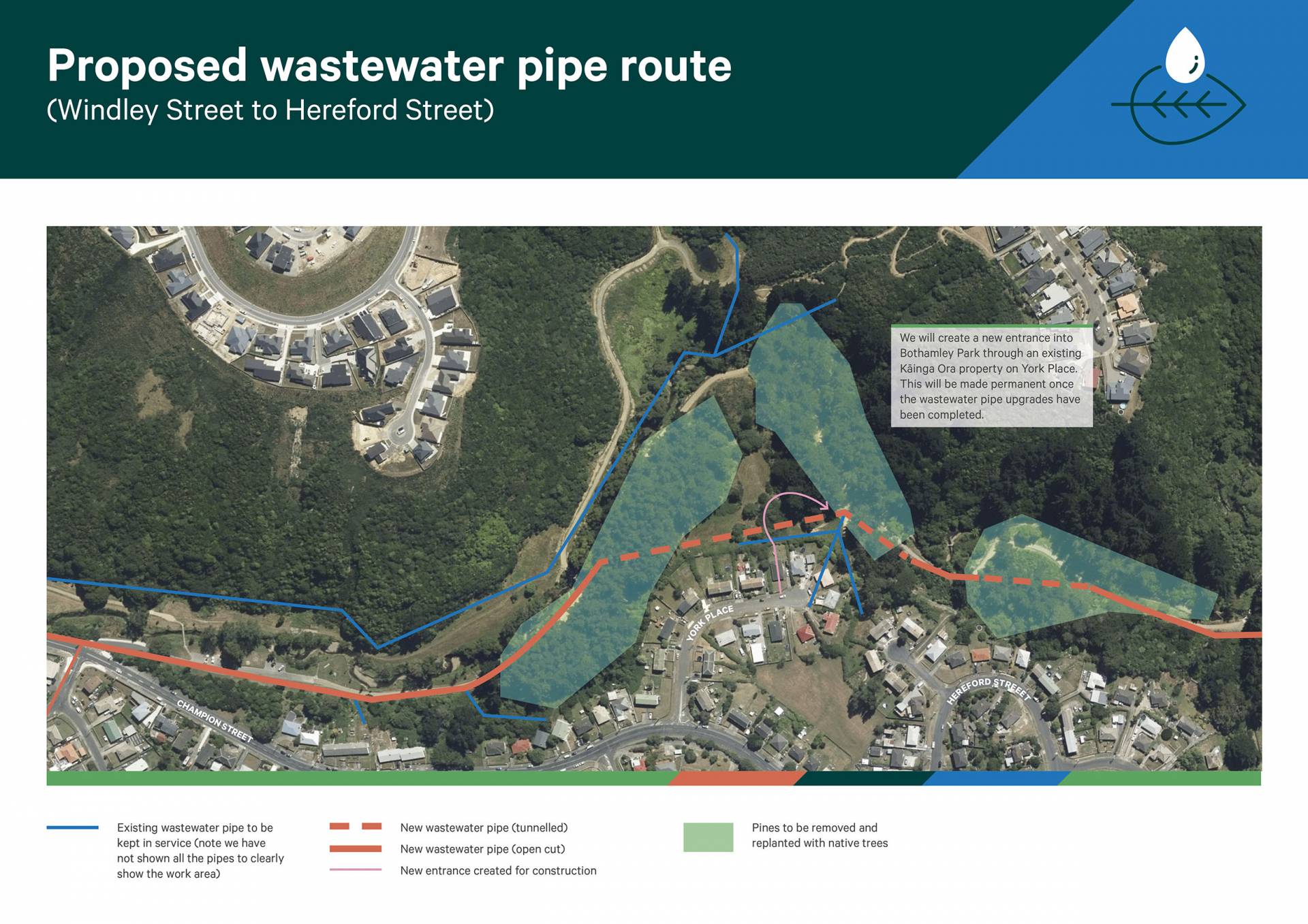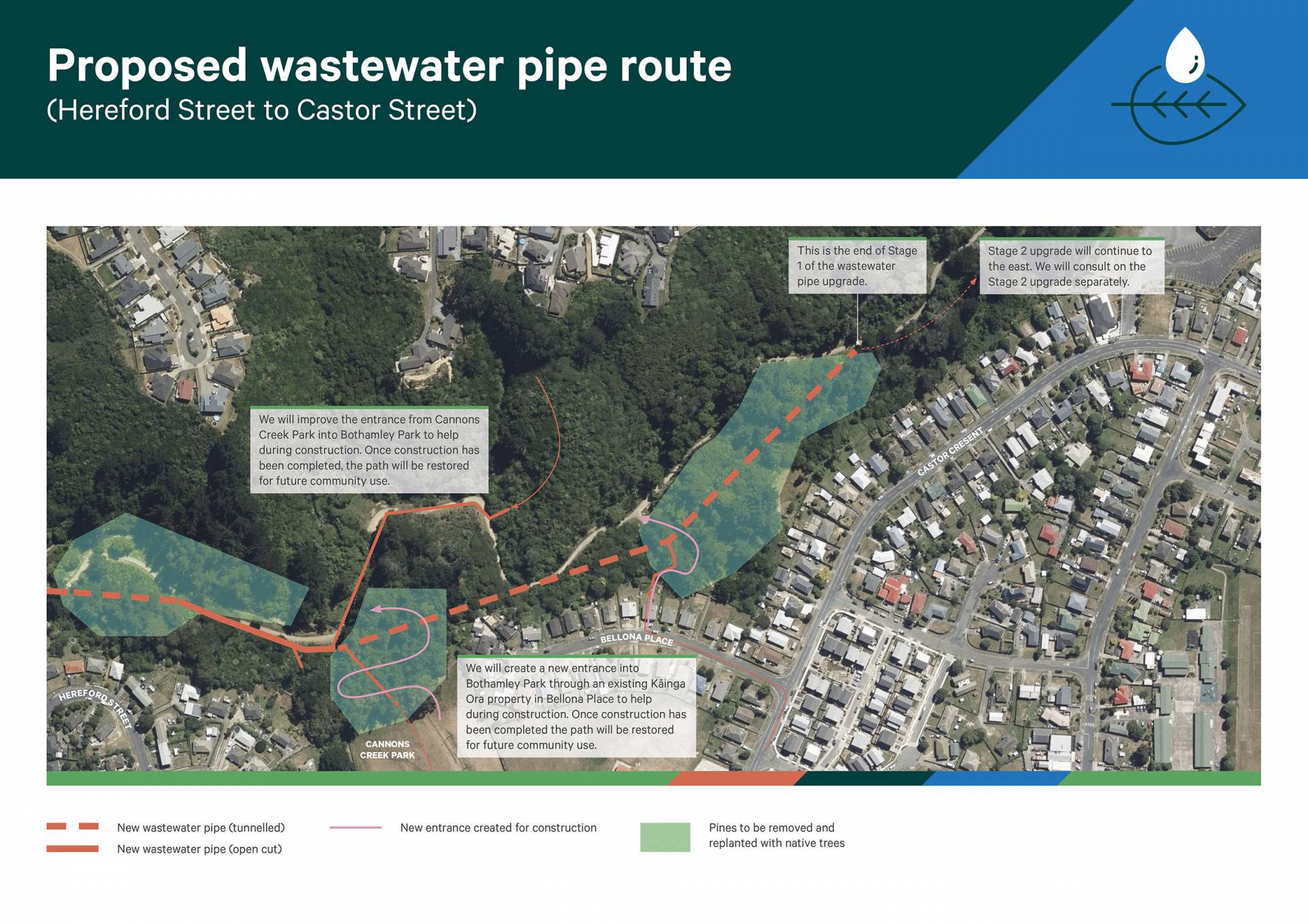Upgrading the wastewater pipes
Over the last few years we’ve been investigating the ground conditions through the park. This has helped us to learn more about the make up of the area and where the best places will be to lay the new pipes. Below is where we are putting in the new wastewater pipes.
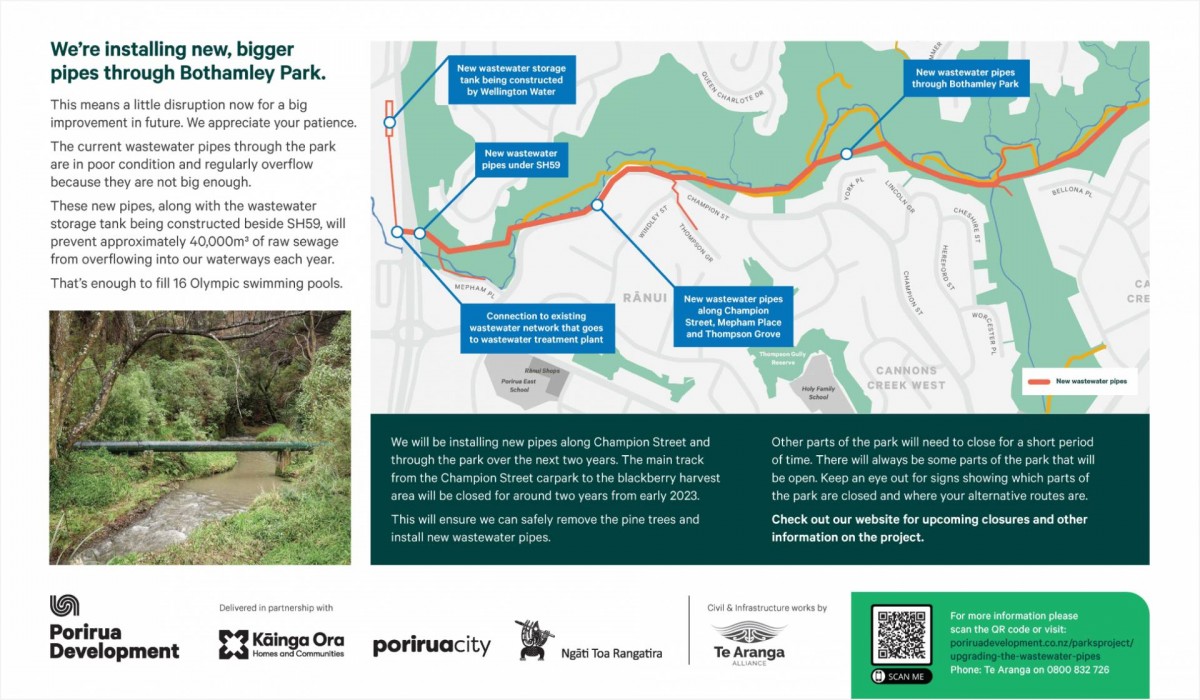
Summary of how we could fix Bothamley Park's wastewater pipes
The opportunities
Instead of just replacing the wastewater pipes, we wanted to make improvements that will not only be better for our environment and community, but also help improve the look and feel of Bothamley Park. We are to lay new wastewater pipes that will:
- Minimise the amount of raw sewage overflowing into waterways
- Be built with environmentally responsible materials that will last generations
- Remove 10 existing above-ground stream crossings
- Reduce the number of visible stream crossings, with only three new stream crossings required, all of which are below the stream bed
- Have fewer manholes
- Be more resilient in natural events i.e. earthquakes
- Improve entrances into the park
It's a big job!
We have started upgrading the wastewater pipes through Bothamley Park. Click on each map for a better picture of the proposed pipe route and how we are doing to improve the wastewater pipes through the park:
Key things you need to know
- The main track from the Champion Street carpark to the blackberry harvest area will need to close for approximately two years from the beginning of 2023.
- Other parts of the park will close for short periods of time but there will always be parts of the park open for walking, cycling and for the community to enjoy.
- Champion Street will be required to close for a period of time, read more here
- We will work with Porirua City Council, Waka Kotahi and others to minimise noise, dust and traffic disruption as well as to keep the community safe while we upgrade the wastewater pipes.
- For local residents who live close to the park and are more impacted by the works, we will make sure you know ahead of time of the upcoming works.
- To complete this work as safely and quickly as possible, we will need to remove some of the pine trees through Bothamley Park. This provides an opportunity to landscape and replant key areas within the park.
- We will work closely with the community and our development partners, Ngāti Toa Rangatira and Porirua City Council, to create something that meets today’s aspirations and is also sustainable for future generations.
Click here for a PDF factsheet about the wastewater pipe upgrade
Click here to see the latest update
Bothamley Park frequently asked questions
To help answer some questions you may have about the upgrade to Bothamley Park's wastewater pipes, please read below to read our FAQs;
Click here for FAQs on Wastewater Pipes Project | Click here for FAQs on the pine tree removal
-
How long will it take to upgrade the wastewater pipes through Bothamley Park?
We anticipate it will take around two years (from Dec 2022) to complete the wastewater pipes upgrade through Bothamley Park. Next year we will be able to share a revised timeline for works. If there are to be any changes to the timeline, we will keep the community updated.
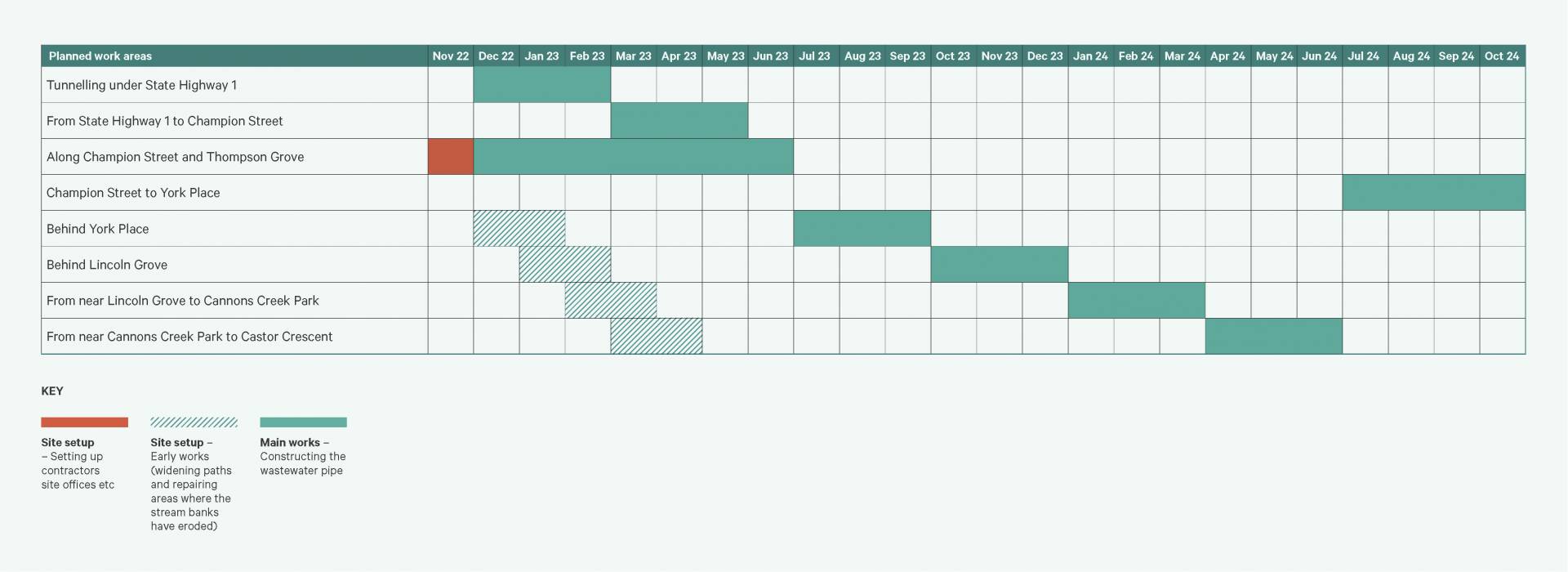
-
How did you come up with the wastewater pipes option?
When designing the wastewater pipes route we had an opportunity to make improvements that would benefit both te taiao, and the community. To achieve this specialists have done a lot of investigation work and ground testing through Bothamley Park.
We wanted to create pipes that would:
- Improve water quality in Kenepuru Stream and Te Awarua-o-Porirua Harbour by significantly reducing the amount of raw sewage overflowing into waterways
- Be built with environmentally responsible materials that will last generations
- Improve the look and feel of the park by significantly reducing (more than half) the number of places the pipe crosses the streams well as reducing the amount of manholes.
- Be more resilient in natural events i.e. earthquakes
- Improve park paths
-
What will the new wastewater pipes be made of?
We will replace the current mix of steel and concrete pipes with polyethylene pipes. This material has been proven to be long lasting, more resilient to earthquakes and gives greater flexibility for choosing where we can lay the new wastewater pipes.
-
How big will the new wastewater pipes be?
The current wastewater pipes are 450mm in diameter/height. To ensure we invest in pipes that will not only cope with current wastewater, but also population growth in the future, the new pipes will be around 900mm diameter/height.
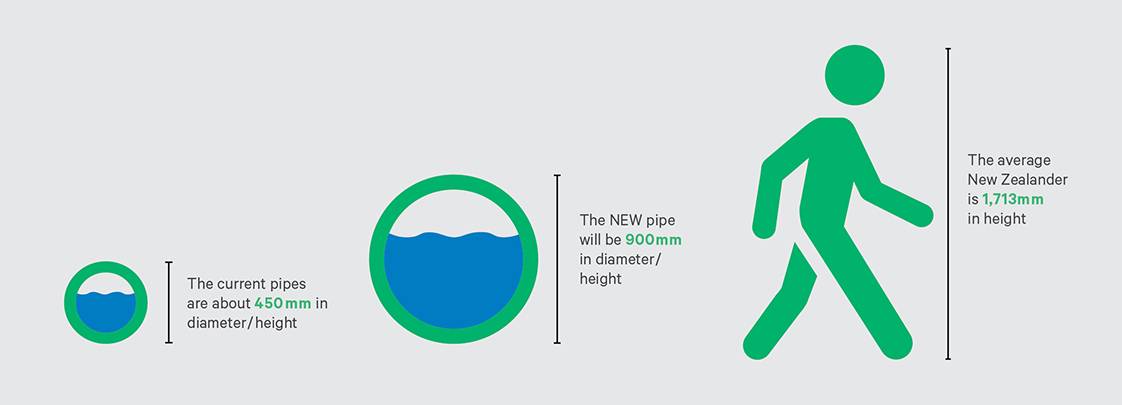
-
How will this be delivered?
We are looking at upgrading the pipes through a couple of different techniques. The first is tunnelling where we use a machine to drill a hole through the soil. The second is open cut. This is where we dig a trench, lay the pipe and then fill the trench back in.
Where possible we are trying to reduce the number of visible pipes and stream crossings through the park.
-
Will you be closing the park or roads?
To complete the pipes upgrade as safely and quickly as possible with minimal disruption to local residents and park users we will need to temporarily close portions of Bothamley Park and Champion Street.
-
How long will you need to close the parks or roads?
We expect Stage 1 of the upgrade to take about 2 years then stage 2 and 3 an additional year. The work will proceed in different sections of the park through this period, so different parts of the park would need to be closed while the construction work is being undertaken in each location.
The closures were formally notified under the Reserves Act, and will be clearly signposted in advance of a particular area closing. Parkrun will be relocated to an alternative site in Plimmerton for approximately two years while the main track through the park is affected.
-
Why are you upgrading the wastewater pipes?
When it rains, stormwater gets into the pipes. When this happens, untreated sewage overflows from manholes and runs into our waterways. Untreated wastewater getting into the stream poses a risk to our health, kills fish and other life in the stream, and prevents locals from collecting healthy kai moana (seafood).
It is currently estimated that 40,000m3 of untreated wastewater overflows into Kenepuru Stream in a typical year. That’s enough to fill 16 Olympic swimming pools! As more houses are built in the area, this puts even more pressure on Bothamley Park’s wastewater pipe and results in more overflows of untreated sewage.
-
Will replacing the wastewater pipe solve sewage pollution into our waterways?
Investigation from a range of partners, local government and government agencies has identified three opportunities to help to fix our wastewater problems:
- Upgrade the Bothamley Park wastewater pipes with newer, larger pipes.
This will be installed along a similar route as existing pipes and where possible, we will lay the pipes underground, rather than across Kenepuru Stream. - Build a large wastewater storage tank just north of the Porirua Station carpark.
Wastewater will overflow into this tank when there is not enough capacity in the wastewater network downstream, instead of overflowing into Kenepuru Stream. This work is currently underway and being led by Wellington Water. - Renew old, leaky pipes within eastern Porirua to reduce the amount of stormwater that gets into the wastewater pipe.
Together, these three improvements are designed to significantly reduce overflows of untreated sewage into waterways in eastern Porirua. This current work is focused on the first of these opportunities – upgrading the wastewater pipes through Bothamley Park
- Upgrade the Bothamley Park wastewater pipes with newer, larger pipes.
-
Currently there are special places in the park, what will happen to them during the construction?
We have been working with Porirua City Council, Ngāti Toa Rangatira and local community groups to ensure places valued by the community are protected and maintained during construction.
-
What will you be doing about construction noise or vibration?
Specialists are looking at how we minimise noise or vibration during construction. A detailed construction plan in line with New Zealand standards and guidance has been prepared, as required by our consent.
We will also monitor and test during construction to ensure noise and vibration are kept to a safe standard.
-
What are you proposing to do about access for walkers, runners or cyclists?
We will be constructing a new path on the north side of the stream opposite the Champion Street carpark, to provide an additional route through the park while the works are taking place. When the main track is closed from Champion Street carpark to the blackberry harvest area, walkers, runners and cyclists will need to divert through the streets in Cannons Creek (if they are taking through route), or use another area of the park (if they are just using the park for recreation).
Parkrun are relocating to Plimmerton while the main track is closed.
-
What will you be doing to reduce dust and mud during construction?
Our construction planning includes making sure that industry good practice standards are in place so that any dust or mud is minimised. Proven techniques include lightly spraying water on site to keep any soil damp, doing work in stages to avoid disturbing large areas, and using straw or other materials.
-
What about construction traffic?
We will have to move some large equipment, significant amounts of materials and workers to and from the construction areas. We will prepare traffic management plans that minimise disruption and keep the community safe during construction, and these will be approved by Porirua City Council and/or Waka Kotahi, as required by our consent.
-
Who will deliver the work?
Te Rā Nui, Eastern Porirua Development is a partnership between Kāinga Ora, Porirua City Council and Ngāti Toa Rangatira. To remove and replace the wastewater pipes, Porirua Development have contracted construction and infrastructure experts Te Aranga to deliver the work. Te Aranga Alliance is a partnership of construction and infrastructure experts Higgins, Goodman, Beca, Harrison Grierson and Orogen with Kāinga Ora, Porirua City Council and Ngāti Toa Rangatira.
Pine tree removal frequently asked questions
To help install new wastewater pipes as safely and quickly as we have removed many pine trees along the ridgeline of Cannons Creek Park, as well as trees through Bothamley Park.
-
Why are you removing trees?
As with all living things, trees have a life cycle. Since February 2022, there have been 15 incidents where individual or groups of trees have fallen.
The trees through Bothamley and Cannons Creek Park were planted around 50 years ago which means many are now at the end of their life cycle.
To help reduce the risk to public using the park and houses along the ridgeline, we have an opportunity with the wastewater pipes upgrade to remove any trees that are vulnerable. Removing some of the trees will not only future proof the park but also create an opportunity to replant and landscape the area to make it more environmentally sustainable, safer and user friendly for the community.
-
What areas will you be removing trees?
We have had to remove all the pines trees that are near the walking track or neighbouring houses between Bellona Place and Champion Street. In addition, work will be starting shortly to remove the pine trees along the ridgeline in Cannons Creek Park.
-
With the removal of the trees will wildlife lose their habitat?
Many of the pine trees will remain in Bothamley Park. We will be leaving some of the trees that are well away from the main track through Bothamley Park, as well as the trees in the eastern parts of the park, near Waitangirua, because these are not affected by the wastewater pipe works. Leaving these trees will keep some habitat for birds that like roosting in high trees.
Before we start to fell the trees, we are checking if there are any lizards in the area, and if there are, we will be relocating these to an appropriate alternative location within the park. You might notice some stacks of wood being created in the park. These are to create habitat that is great for the lizards to move into.
-
What kinds of trees will you be removing? Will you be removing any native trees?
We have only identified a range of pine trees and Macrocarpas which are vulnerable and need to be removed from each park.
Pine trees and Macrocarpas are not native to Aotearoa, New Zealand. This work provides an opportunity to replace pine trees with a range of appropriate native plants which will help to support the park’s environment.
-
How many trees will you be removing?
Throughout the two parks, we’ve identified around 500 trees that are vulnerable and need to be removed.
-
Will you be replacing the trees post construction?
The tree removal provides an opportunity to landscape and plant a range of native plants throughout the park. We will continue to work alongside local residents, community and development partners Ngāti Toa Rangatira and Porirua City Council to create something that not only meets community aspirations, but is also sustainable for future generations.
-
How long will this work take?
The work will be delivered in stages throughout 2023. To enable work to start on upgrading the wastewater pipes through Bothamley Park, we started removing pine trees in early 2023 and work to remove the pines along the ridgeline in Cannons Creek Park will commence shortly.
-
What about nearby homes? Will they be in danger of damage?
When we fell the trees, we need to make sure that people are a safe distance from the works. The park will be closed in the areas that we are working, and we will ask people in neighbouring homes to be out of their houses when we are felling trees nearby. We expect that people affected may need to be out of their homes for a few hours while the trees nearby are being felled. Our site teams will visit people that are affected and work with them to confirm the exact time that they will need to be out of their homes. The site teams will look to accommodate any requirements that neighbours may have, as much as possible.
-
When will replanting take place?
The areas where trees are being felled will be mulched or hydroseeded (sprayed grass seed) to minimize runoff of sediments (soils) into the stream. In winter 2023, we will begin planting native trees in the areas, where the pine trees have been removed. We have been working with landscape specialists and Ngāti Toa Rangatira to choose the right trees and plants for the park. The trees will be locally grown.
-
Who will be completing this work?
The pines will be removed by a qualified clear felling crew and in some instances arborist crews to safely remove the trees.
-
What consultation took place?
The Reserves Act does not include any consultation requirements specific to pines. However the public notification for the fast track consent for the wastewater pipes upgrade did. In addition, the Wetland engagement also included some information on pine removal specifically in Cannons Creek Park.
-
Who determines how many native plants will be planted and where?
There is a revegetation plan which we have created in partnership with Te Rā Nui, Eastern Porirua Development partners Porirua City Council and Ngāti Toa Rangatira. This is currently being finalised and Porirua City Council will be approving the plan in their capacity as regulatory authority, not in their capacity as land owner.
-
Who do I call if I have a question about the tree felling?
If you have any questions you can call the Porirua City Council contact centre on 04 237 5089, Monday to Friday between 8:00am - 5:00pm to arrange a chat.




